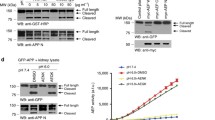Abstract
Proteolytic and amyloidogenic processing of amyloid precursor protein (APP) by β- and γ-secretases are pathological hallmarks of Alzheimer’s disease (AD). These proteolytic activities lead to release of the amyloid-β peptides believed to cause neurological pathology and be linked to pathological progression in AD. Due to its capability to cleave APP within the toxic peptide sequence, the metalloproteinase ADAM10 (“a disintegrin and metalloprotease”) is a known antagonist of the disease-causing pathway. ADAM10 also plays a major role in the ectodomain shedding of a number of important cell surface proteins. In addition, ADAM10 is involved in the proteolytic activation cascade of the Notch receptor, which is of crucial function in developmental processes. The study of ADAM10-deficient mice also revealed that ADAM10 regulates synaptic function and synaptogenesis. Pharmacological activation of ADAM10 is postulated to represent a valuable strategy for prevention of AD. However, due to the multiple roles of ADAM10 in the brain, it will be challenging to find a suitable therapeutic window.




Similar content being viewed by others
References
Altmeppen HC, Prox J, Puig B et al (2011) Lack of a-disintegrin-and-metalloproteinase ADAM10 leads to intracellular accumulation and loss of shedding of the cellular prion protein in vivo. Mol Neurodegener 6:36
Jorissen E, Prox J, Bernreuther C et al (2010) The disintegrin/metalloproteinase ADAM10 is essential for the establishment of the brain cortex. J Neurosci 30:4833–4844
Kuhn PH, Wang H, Dislich B et al (2010) ADAM10 is the physiologically relevant, constitutive alpha-secretase of the amyloid precursor protein in primary neurons. EMBO J 29:3020–3032
Postina R, Schroeder A, Dewachter I et al (2004) A disintegrin-metalloproteinase prevents amyloid plaque formation and hippocampal defects in an Alzheimer disease mouse model. J Clin Invest 113:1456–1464
Prox J, Bernreuther C, Altmeppen H et al (2013) Postnatal disruption of the disintegrin/metalloproteinase ADAM10 in brain causes epileptic seizures, learning deficits, altered spine morphology, and defective synaptic functions. J Neurosci 33:12915–12928
Prox, J, Rittger, A, Saftig (2012) Physiological functions of the amyloid precursor protein secretases ADAM10, BACE1, and presenilin.Exp. Brain Res 217:331–341
Prox J, Willenbrock M, Weber S et al (2012) Tetraspanin15 regulates cellular trafficking and activity of the ectodomain sheddase ADAM10. Cell Mol Life Sci 69:2919–2932
Reiss K, Saftig P (2009) The “a disintegrin and metalloprotease” (ADAM) family of sheddases: physiological and cellular functions. Semin Cell Dev Biol 20:126–137
Suh J, Choi SH, Romano DM et al (2013) ADAM10 missense mutations potentiate β-amyloid accumulation by impairing prodomain chaperone function. Neuron 80:385–401
Suzuki K, Hayashi Y, Nakahara S et al (2012) Activity-dependent proteolytic cleavage of neuroligin-1. Neuron 76:410–422
Weber S, Saftig P (2013) Ectodomain shedding and ADAMs in development. Development 139:3693–3709
Acknowledgement
Our work is funded by the DFG (SFB877: Proteolysis as a Regulatory Event in Pathophysiology).
Compliance with ethical guidelines
Conflict of interest. J. Prox and P. Saftig state that there are no conflicts of interest. The accompanying manuscript does not include studies on humans or animals.
Author information
Authors and Affiliations
Corresponding author
Additional information
A complete list of references can be requested from the authors.
Rights and permissions
About this article
Cite this article
Saftig, P., Prox, J. ADAM10: α-secretase in Alzheimer’s disease and regulator of neurobiology. e-Neuroforum 5, 37–42 (2014). https://doi.org/10.1007/s13295-014-0055-7
Published:
Issue Date:
DOI: https://doi.org/10.1007/s13295-014-0055-7




